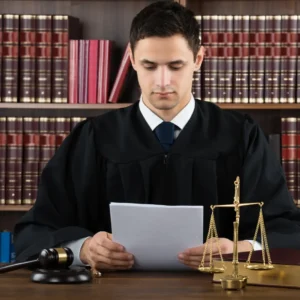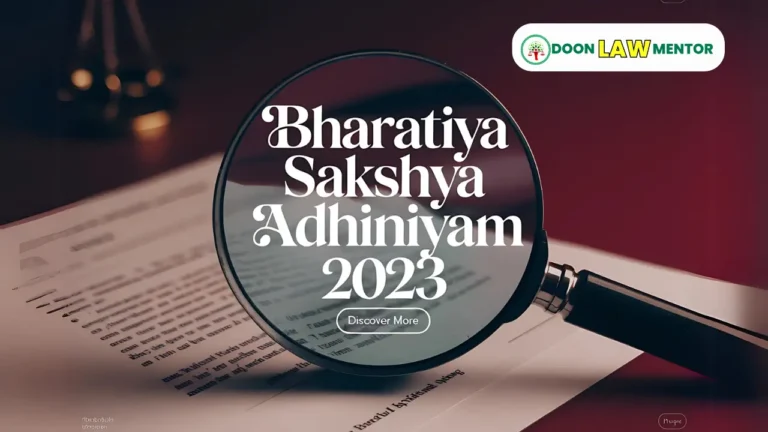The Kesavananda Bharati Case (1973) introduced the Basic Structure Doctrine, limiting Parliament’s amendment powers. Explore the legal issues, Supreme Court’s reasoning, and implications for lawyers and law students with Doon Law Mentor’s expert analysis of this landmark judgment.
Table of Contents
Introduction
Can Parliament amend the Constitution without limits? The Kesavananda Bharati Case (1973) answered this critical question. This landmark Supreme Court ruling introduced the Basic Structure Doctrine, reshaping India’s constitutional law. For lawyers and law students, understanding the Kesavananda Bharati Case is essential. It defined the balance between parliamentary power and constitutional integrity. This article, guided by Doon Law Mentor, provides a detailed legal analysis of the Kesavananda Bharati Case, its main legal issues, the Court’s observations and reasoning, constitutional framework, and lasting impact.
Historical Background of the Kesavananda Bharati Case
Context of Constitutional Amendments
The Kesavananda Bharati Case emerged during a period of constitutional tension in India. Between 1951 and 1972, Parliament passed several amendments to enable land reforms and nationalization, often clashing with fundamental rights. The Supreme Court’s rulings in Shankari Prasad (1951) and Sajjan Singh (1965) upheld Parliament’s unlimited power to amend the Constitution under Article 368. However, Golaknath v. State of Punjab (1967) limited this power, ruling that fundamental rights could not be amended. The Kesavananda Bharati Case was triggered by Parliament’s response to Golaknath through the 24th, 25th, and 29th Constitutional Amendments.
Factual Background
The Kesavananda Bharati Case was filed by Swami Kesavananda Bharati, head of the Edneer Mutt in Kerala. The Kerala Land Reforms Act, 1969, restricted the mutt’s land management rights. The 25th Amendment, which curtailed the right to property, and the 29th Amendment, which protected certain state laws from judicial review, were challenged. The Kesavananda Bharati Case became a battleground for defining Parliament’s amendment powers.
Constitutional Crisis
The Kesavananda Bharati Case arose amid a power struggle between the judiciary and the legislature. The government, led by Prime Minister Indira Gandhi, sought to assert parliamentary supremacy. The Supreme Court aimed to protect the Constitution’s core principles. The Kesavananda Bharati Case was heard by a 13-judge bench, the largest in India’s judicial history, to resolve this conflict.
Main Legal Issues in the Kesavananda Bharati Case
The Kesavananda Bharati Case addressed three main legal issues:
- Scope of Article 368: Does Article 368 grant Parliament unlimited power to amend the Constitution, including fundamental rights?
- Limits on Amendment Power: Can Parliament amend the Constitution to alter or destroy its basic structure?
- Judicial Review of Amendments: Can the Supreme Court review constitutional amendments to protect the Constitution’s essential features?
These issues centered on the Kesavananda Bharati Case’s core question: the extent of Parliament’s power to amend the Constitution.
Supreme Court’s Observations, Decisions, and Reasoning
Issue 1: Scope of Article 368
Observation: The Supreme Court observed that Article 368 governs the procedure for constitutional amendments. Previous cases like Shankari Prasad and Sajjan Singh held that Parliament’s amendment power was unlimited, while Golaknath restricted amendments affecting fundamental rights. The Kesavananda Bharati Case required reconciling these conflicting precedents.
Decision: The Court, in a 7:6 majority, overruled Golaknath and held that Article 368 allows Parliament to amend any part of the Constitution, including fundamental rights. However, this power is not unlimited.
Reasoning: The majority reasoned that Article 368’s text does not explicitly restrict amendments to fundamental rights. The Kesavananda Bharati Case rejected Golaknath’s view that fundamental rights are unamendable, as it would freeze the Constitution. However, the Court introduced the Basic Structure Doctrine to limit amendments that destroy the Constitution’s core identity. The Kesavananda Bharati Case balanced parliamentary flexibility with constitutional integrity.
Read More: Berubari Union Case: Legal Analysis of India’s Territorial Cession
Issue 2: Limits on Amendment Power
Observation: The Court observed that unlimited amendment power could allow Parliament to alter the Constitution’s fundamental character, such as its democratic or federal nature. The Kesavananda Bharati Case examined whether the Constitution’s essential features are protected from such changes.
Decision: Parliament cannot amend the Constitution’s basic structure. The Kesavananda Bharati Case introduced the Basic Structure Doctrine, identifying features like judicial review, democracy, and secularism as unamendable.
Reasoning: The majority reasoned that the term “amend” in Article 368 implies improvement, not destruction. The Kesavananda Bharati Case held that the Constitution’s basic structure forms its identity, which Parliament cannot abolish. Justices like S.M. Sikri and H.R. Khanna emphasized that features like the rule of law and separation of powers are inviolable. The Kesavananda Bharati Case ensured the Constitution’s core remains intact.
Issue 3: Judicial Review of Amendments
Observation: The Court observed that judicial review is a cornerstone of constitutional governance. The Kesavananda Bharati Case considered whether courts can review amendments to ensure they do not violate the basic structure. The 24th and 29th Amendments, limiting judicial review, were under scrutiny.
Decision: The Supreme Court has the power to review constitutional amendments to ensure they do not violate the basic structure. The Kesavananda Bharati Case upheld parts of the 24th and 25th Amendments but struck down clauses ousting judicial review.
Reasoning: The Court reasoned that judicial review is part of the basic structure, as it protects constitutional supremacy. The Kesavananda Bharati Case struck down the second part of Article 31C (introduced by the 25th Amendment), which barred judicial review of laws implementing certain directive principles. The Kesavananda Bharati Case affirmed the judiciary’s role in safeguarding the Constitution.
Additional Observations: The Basic Structure Doctrine
The Kesavananda Bharati Case introduced the Basic Structure Doctrine, a judicial innovation. The majority did not provide an exhaustive list but identified key features, including:
- Supremacy of the Constitution.
- Democratic and republican form of government.
- Secularism.
- Separation of powers.
- Judicial review.
- Federalism.
The Kesavananda Bharati Case left the doctrine flexible, allowing future courts to define its scope.
Outcome of the Kesavananda Bharati Case
Majority Ruling
In a 7:6 decision, the Kesavananda Bharati Case upheld the validity of the 24th, 25th, and 29th Amendments, except for provisions ousting judicial review. The Basic Structure Doctrine became a permanent check on Parliament’s amendment powers.
Bench Composition
The 13-judge bench, led by Chief Justice S.M. Sikri, included Justices J.M. Shelat, K.S. Hegde, A.N. Grover, A.N. Ray, P. Jaganmohan Reddy, D.G. Palekar, H.R. Khanna, K.K. Mathew, M.H. Beg, S.N. Dwivedi, A.K. Mukherjea, and Y.V. Chandrachud. The ruling, delivered on April 24, 1973, was a landmark in constitutional law.
Subsequent Developments
The Kesavananda Bharati Case faced resistance. The 42nd Amendment (1976) attempted to curb judicial review, but later cases like Minerva Mills (1980) reaffirmed the Basic Structure Doctrine. The Kesavananda Bharati Case remains a cornerstone of Indian jurisprudence.
Case Study: Impact on Land Reforms
Kerala Land Reforms
The Kesavananda Bharati Case arose from the Kerala Land Reforms Act, 1969, which restricted the Edneer Mutt’s land rights. The 25th Amendment protected such laws from judicial scrutiny under Article 31C. The Court upheld Article 31C’s first part but struck down its judicial review bar.
Legal Implications
The Kesavananda Bharati Case allowed land reforms to proceed while preserving judicial oversight. It ensured that state laws align with the Constitution’s basic structure, balancing social justice with constitutional integrity.
Sociopolitical Impact
The Kesavananda Bharati Case resolved tensions between the government’s reform agenda and judicial authority. It protected the judiciary’s role, preventing legislative overreach.
Comparative Analysis: Kesavananda Bharati Case vs. Other Landmark Cases
Shankari Prasad v. Union of India (1951)
The Kesavananda Bharati Case overruled Shankari Prasad’s view of unlimited amendment powers. While Shankari Prasad upheld Parliament’s authority to amend fundamental rights, the Kesavananda Bharati Case introduced limits via the Basic Structure Doctrine.
Golaknath v. State of Punjab (1967)
The Kesavananda Bharati Case overruled Golaknath’s blanket ban on amending fundamental rights. It adopted a middle ground, allowing amendments but protecting the basic structure.
Minerva Mills v. Union of India (1980)
The Kesavananda Bharati Case’s Basic Structure Doctrine was reaffirmed in Minerva Mills, which struck down parts of the 42nd Amendment. The Kesavananda Bharati Case provided the foundation for limiting excessive amendments.
Implications of the Kesavananda Bharati Case
Constitutional Supremacy
The Kesavananda Bharati Case established the Constitution’s supremacy over parliamentary power. The Basic Structure Doctrine ensures that core principles remain unalterable.
Judicial Independence
The Kesavananda Bharati Case strengthened judicial review, affirming the judiciary’s role as the Constitution’s guardian. It protected democratic institutions from legislative overreach.
Precedent for Future Cases
The Kesavananda Bharati Case influenced cases like Indira Nehru Gandhi (1975) and S.R. Bommai (1994), where the Basic Structure Doctrine was applied to protect secularism and federalism.
Read More: Unlawful Assembly and Public Tranquility in the Bharatiya Nyaya Sanhita 2023
Challenges and Criticisms
Vague Doctrine
The Kesavananda Bharati Case’s Basic Structure Doctrine was criticized for its ambiguity. The lack of a definitive list of basic features allows judicial discretion, raising concerns about subjectivity.
Judicial Overreach
Critics argued that the Kesavananda Bharati Case granted excessive power to the judiciary, undermining parliamentary sovereignty. The government’s push for the 42nd Amendment reflected this tension.
Political Backlash
The Kesavananda Bharati Case led to political friction, culminating in the 1975 Emergency. The judiciary’s assertion of power challenged the government’s reform agenda.
Table: Key Aspects of the Kesavananda Bharati Case
| Aspect | Description | Role in Kesavananda Bharati Case |
|---|---|---|
| Issue 1 | Scope of Article 368 | Allowed amendments to fundamental rights but with limits. |
| Issue 2 | Limits on amendment power | Introduced Basic Structure Doctrine to protect essential features. |
| Issue 3 | Judicial review of amendments | Upheld judiciary’s power to review amendments for basic structure violations. |
| Basic Structure | Core constitutional features | Protected democracy, secularism, and judicial review. |
This table, created by Doon Law Mentor, summarizes the Kesavananda Bharati Case’s framework.
Conclusion: A Pillar of Constitutional Law
The Kesavananda Bharati Case is a landmark in India’s constitutional history. It introduced the Basic Structure Doctrine, limiting Parliament’s amendment powers while preserving constitutional integrity. For lawyers and law students, the Kesavananda Bharati Case is a critical study in judicial review and constitutional supremacy. It balanced legislative flexibility with the Constitution’s core principles, shaping India’s legal landscape. Join Doon Law Mentor at doonlawmentor.com for expert resources and mock tests to master such landmark cases.
FAQs
What is the Kesavananda Bharati Case?
The Kesavananda Bharati Case (1973) introduced the Basic Structure Doctrine, limiting Parliament’s power to amend the Constitution’s core features.
What is the Basic Structure Doctrine?
The Kesavananda Bharati Case held that Parliament cannot amend the Constitution’s basic structure, like democracy and judicial review.
Why was the case significant?
The Kesavananda Bharati Case protected constitutional integrity, ensuring judicial review and limiting legislative overreach.
What amendments were challenged?
The Kesavananda Bharati Case examined the 24th, 25th, and 29th Amendments, upholding most but striking down judicial review bars.
How does it impact today?
The Kesavananda Bharati Case guides constitutional amendments, ensuring core principles like secularism remain intact.
#KesavanandaBharatiCase #BasicStructureDoctrine #Article368 #SupremeCourtIndia #DoonLawMentor #judicialSage #JudicialYogi









